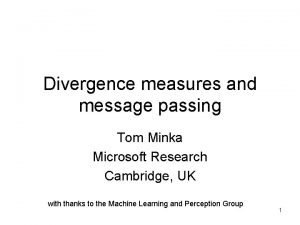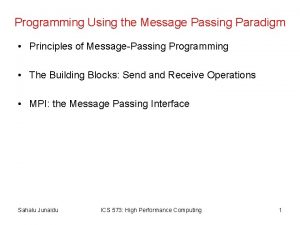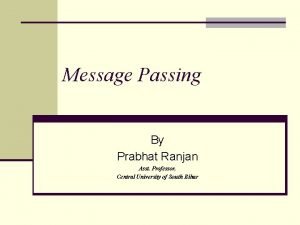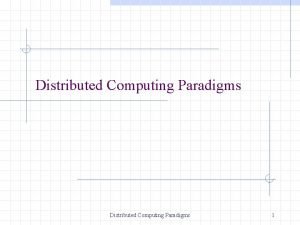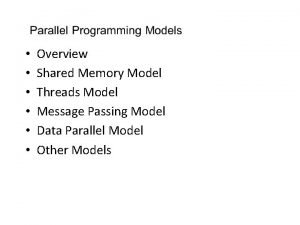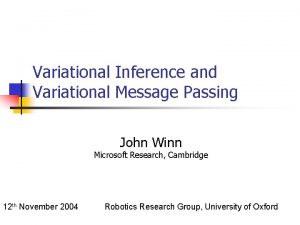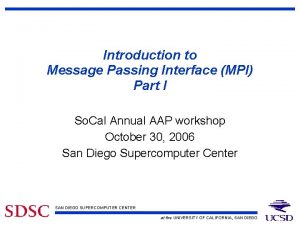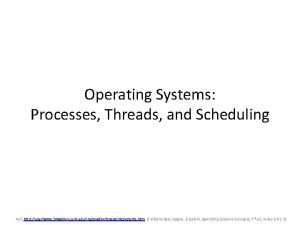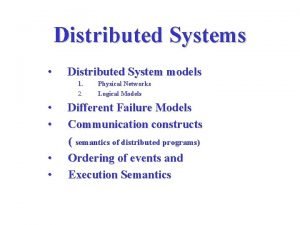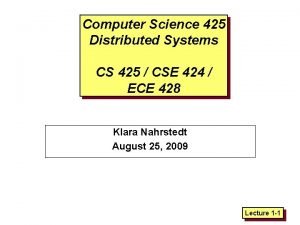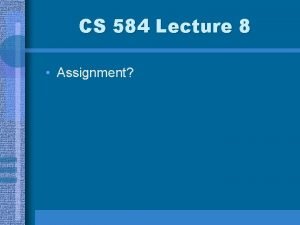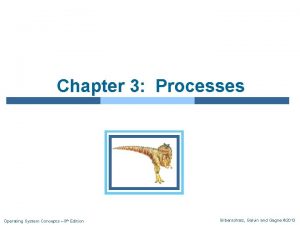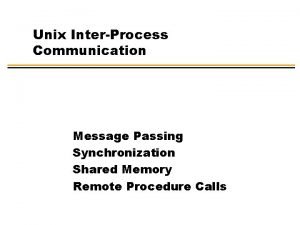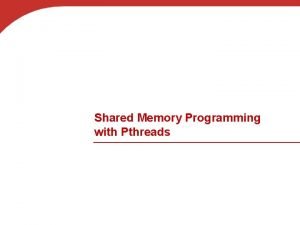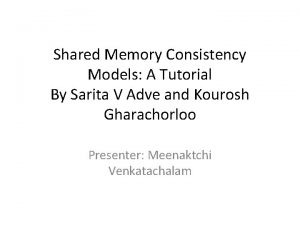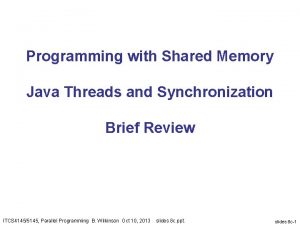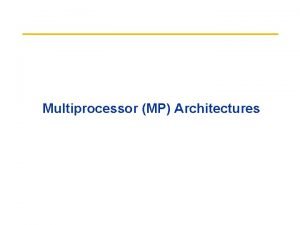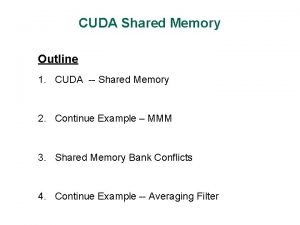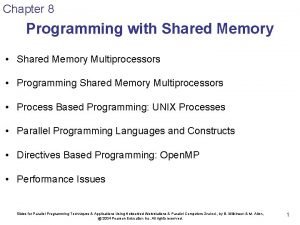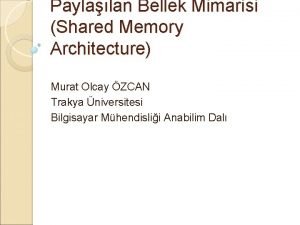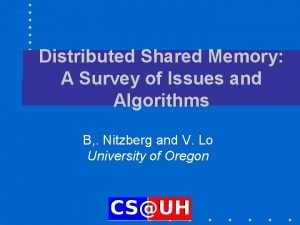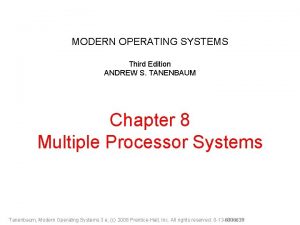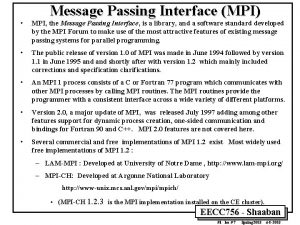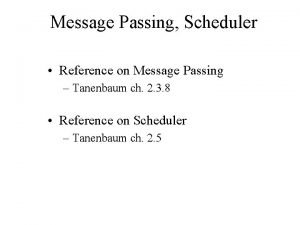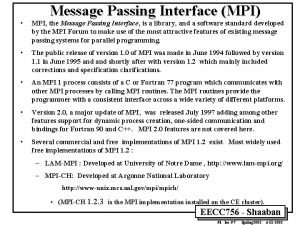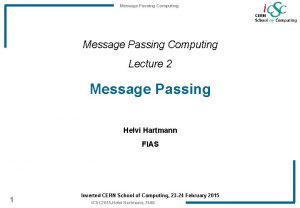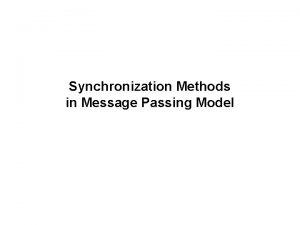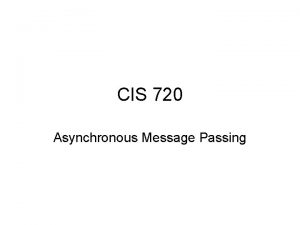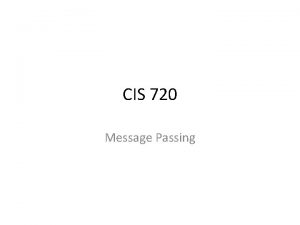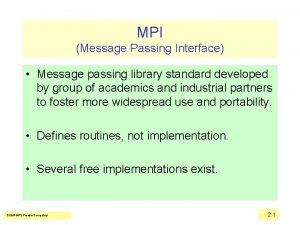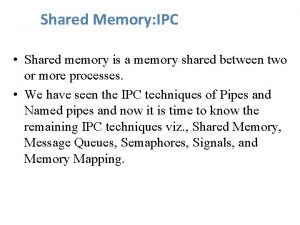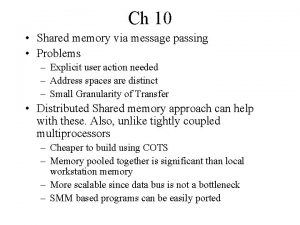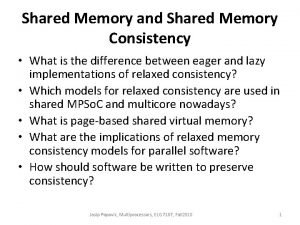Shared Memory and Message Passing WA 1 2
































- Slides: 32

Shared Memory and Message Passing W+A 1. 2. 1, 1. 2. 2, 1. 2. 3, 2. 1. 2, 2. 1. 3, 8. 3, 9. 2. 1, 9. 2. 2 Akl 2. 5. 2 CSE 160/Berman

Models for Communication • Parallel program = program composed of tasks (processes) which communicate to accomplish an overall computational goal • Two prevalent models for communication: – Message passing (MP) – Shared memory (SM) • This lecture will focus on MP and SM computing CSE 160/Berman

Message Passing Communication • Processes in message passing program communicate by passing messages A B • Basic message passing primitives – Send(parameter list) – Receive(parameter list) – Parameters depend on the software and can be complex CSE 160/Berman

Flavors of message passing • Synchronous used for routines that return when the message transfer has been completed – Synchronous send waits until the complete message can be accepted by the receiving process before sending the message (send suspends until receive) – Synchronous receive will wait until the message it is expecting arrives (receive suspends until message sent) – Also called blocking request to send A acknowledgement message CSE 160/Berman B

Nonblocking message passing • Nonblocking sends return whether or not the message has been received – If receiving processor not ready, message may be stored in message buffer – Message buffer used to hold messages being sent by A prior to being accepted by receive in B message buffer A B – MPI: • routines that use a message buffer and return after their local actions complete are blocking (even though message transfer may not be complete) • Routines that return immediately CSE 160/Berman are non-blocking

Architectural support for MP • Interconnection network should provide connectivity, low latency, high bandwidth Interconnection Network • Many interconnection networks developed over last 2 decades Processor – Hypercube – Mesh, torus – Ring, etc. … Local memory Basic Message Passing Multicomputer CSE 160/Berman

Shared Memory Communication • Processes in shared memory program communicate by accessing shared variables and data structures • Basic shared memory primitives Interconnection Media Basic Shared Memory Multiprocessor CSE 160/Berman memories … Processors … – Read to a shared variable – Write to a shared variable

Accessing Shared Variables • Conflicts may arise if multiple processes want to write to a shared variable at the same time. Process A, B: read x compute x+1 write x Shared variable x +1 proc. A +1 proc. B • Programmer, language, and/or architecture must provide means of resolving conflicts CSE 160/Berman

Architectural Support for SM • 4 basic types of interconnection media: – Bus – Crossbar switch – Multistage network – Interconnection network with distributed shared memory CSE 160/Berman

Limited Scalability Media I • Bus – Bus acts as a “party line” between processors and shared memories – Bus provides uniform access to shared memory (UMA) – When bus saturates, performance of system degrades – For this reason, bus-based systems do not scale to more than 30 -40 processors [Sequent Symmetry, Balance] memory … memory bus processor … CSE 160/Berman processor

Limited Scalability Media II • Crossbar – Crossbar switch connects m processors and n memories with distinct paths between each processor/memory pair – Crossbar provides uniform access to shared memory (UMA) – O(mn) switches required for m processors and n memories – Crossbar scalable in terms of performance but not in terms of cost, used for basic switching mechanism in SP 2 P 1 P 2 P 3 P 4 P 5 160/Berman M 1 CSE M 2 M 3 M 4 M 5

Multistage Networks • Multistage networks provide more scalable performance than bus but less costly to scale than crossbar • Typically max{logn, logm} stages connect n processors and m shared memories • “Omega” networks (butterfly, shuffle-exchange) commonly used for multistage network • Multistage network used for CM-5 (fat-tree connects processor/memory pairs), BBN Butterfly (butterfly), IBM RP 3 (omega) P 1 P 2 P 3 P 4 P 5 Stage 1 Stage 2 … CSE 160/Berman Stage k M 1 M 2 M 3 M 4 M 5

Omega Networks • Butterfly multistage • Shuffle multistage – Used for BBN Butterfly, TC 2000 – Used for RP 3, SP 2 high performance switch 1 2 3 4 A B 1 A 2 B 3 C C D 4 D CSE 160/Berman

Fat-tree Interconnect • Bandwidth is increased towards the root • Used for data network for CM-5 (MIMD MPP) – 4 leaf nodes, internal nodes have 2 or 4 children • To route from leaf A to leaf B, pick random switch C in the least common ancestor fat node of A and B, take unique tree route from A to C and from C to B Binary fat-tree in which all internal nodes have two children CSE 160/Berman

Distributed Shared Memory • Memory is physically distributed but programmed as shared memory – Programmers find shared memory paradigm desirable – Shared memory distributed among processors, accesses may be sent as messages – Access to local memory and global shared memory creates NUMA (non-uniform memory access architectures) – BBN butterfly is NUMA shared memory multiprocessor Interconnection Network Processor and local memory Shared memory P M … BBN butterfly interconnect P M CSE 160/Berman …

Alphabet Soup • Terms for shared memory multiprocessors – NUMA = non-uniform memory access • BBN Butterfly, Cray T 3 E, Origin 2000 – UMA = uniform memory access • Sequent, Sun HPC 1000 – COMA = cache-only memory access • KSR – (NORMA = no remote memory access • message-passing MPPs ) CSE 160/Berman

Using both SM and MP together • Common for platforms to support one model at a time – SM or MP • Clusters of SMPs may be effectively programmed using both SM and MP – SM used within a multiple processor machine/node – MP used between nodes CSE 160/Berman

SM Program: Prefix Sums • Problem: Given n processes {P_i} and n datum {a_i}, want to compute the prefix sums {(a_1+…+ a_j )= A_1 i} such that A_1 i is in P_i upon termination of the algorithm. • We’ll look at an O(log n) SM parallel algorithm which computes the prefix sums of n datum on n processors CSE 160/Berman

Data Movement for Prefix Sums Algorithm • Aij = a_i + a_i+1 + … + a_j P 1 P 2 P 3 P 4 P 5 P 6 P 7 P 8 a_1 a_2 a_3 a_4 a_5 a_6 a_7 a_8 Initial values in shared memories A 11 A 12 A 23 A 34 A 45 A 56 A 67 A 78 A 11 A 12 A 13 A 14 A 25 A 36 A 47 A 58 Prefix sums in A 11 A 12 A 13 A 14 A 15 A 16 A 17 A 18 shared memories CSE 160/Berman

Pseudo-code for Prefix Sums Algorithm • Pseudo-code Procedure ALLSUMS(a_1, …, a_n) Initialize P_i with data a_i=Aii for j=0 to (log n) – 1 do forall i = 2^j +1 to n do (parallel for) Processor P_i: (i) obtains contents of P_i-2^j through shared memory and (ii) replaces contents of P_i with contents of P_i-2^j + current contents of P_i end forall Aik A(k+1)j end for CSE 160/Berman Aij

Programming Issues • Algorithm assumes that all additions with the same offset (i. e. for each level) are performed at the same time – Need some way of tagging or synchronizing computations – May be cost-effective to do a barrier synchronization (all processors must reach a “barrier before proceeding to the next level ) between levels • For this algorithm, there are no write conflicts within a level since one of the values is already in the shared variable, the other value need only be summed with the existing value – If two values must be written with existing variable, we would need to establish a well-defined protocol for handling conflicting writes CSE 160/Berman

MP Program: Sorting • Problem: Sorting a list of numbers/keys (rearranging them so as to be in non-decreasing order) • Basic sorting operation: compare/exchange (compare/swap) Send value from P 1 [1 “active”, 1 “passive” Processor] Compare P 1 and P 2 values, retain max of P 1 and P 2 values in P 2 Send min of values to P 1 P 2 • In serial computation (RAM) model, optimal sorting for n keys is. CSE O(nlogn) 160/Berman

Odd-Even Transposition Sort • Parallel version of bubblesort – many compareexchanges done simultaneously • Algorithm consists of Odd Phases and Even Phases – In even phase, even-numbered processes exchange numbers (via messages) with their right neighbor – In odd phase, odd-numbered processes exchange numbers (via messages) with their right neighbor • Algorithm alternates odd phase and even phase for O(n) iterations CSE 160/Berman

Odd-Even Transposition Sort • Data Movement P 0 P 1 P 2 P 3 P 4 T=1 T=2 T=3 T=4 T=5 General Pattern for n=5 CSE 160/Berman

Odd-Even Transposition Sort • Example 3 10 4 8 1 P 0 P 1 P 2 P 3 P 4 T=1 3 10 4 8 1 T=2 3 4 10 1 8 T=3 3 4 1 10 8 T=4 3 1 4 8 10 T=5 1 3 4 8 10 General Pattern for n=5 CSE 160/Berman T=0

Odd-Even Transposition Code • Compare-exchange accomplished through message passing • Odd Phase P_i = 0, 2, 4, …, n-2 P_i = 1, 3, 5, …, n-1 recv(&A, P_i+1); send(&B, P_i+1); if (A<B) B=A; send(&A, P_i-1); recv(&B, P_i-1); if (A<B) A=B; • Even Phase P_i = 2, 4, 6, …, n-2 P_i = 1, 3, 5, …, n-3 send(&A, P_i-1); recv(&B, P_i-1); if (A<B) A=B; recv(&A, P_i+1); send(&B, P_i+1); if (A<B) B=A; CSE 160/Berman P 0 P 1 P 2 P 3 P 4

Programming Issues • Algorithm that odd phases and even phases done in sequence – how to synchronize? – Synchronous execution • Need to have barrier between phases • Barrier synchronization costs may be high – Asynchronous execution • Need to tag iteration, phase so that correct values combined – Program may be implemented as SPMD (single program, multiple data) [see HW] CSE 160/Berman

Programming Issues • Algorithm must be mapped to underlying platform – If communication costs >> computation costs, it may be more cost-effective to map multiple processes to a single processor and bundle communication Processor A Processor B P 0 P 1 P 2 P 3 Processor A P 0 P 1 P 2 Processor B P 3 P 4 – granularity (ratio of time required for a basic communication operation to the time required for a basic computation) of underlying platform required to determine best mapping CSE 160/Berman

Is Odd-Even Transposition Sort Optimal? • What is optimal? – An algorithm is optimal if there is a lower bound for the problem it addresses with respect to the basic operation being counted which equals the upper bound given by the algorithm’s complexity function, i. e. lower bound = upper bound CSE 160/Berman

Odd-Even Transposition Sort is optimal on linear array • Upper bound = O(n) • Lower bound = O(n) – Consider sorting algorithms on linear array where basic operation being counted is compare-exchange – If minimum key is in rightmost array element, it must move throughout the course of any algorithm to the leftmost array element 8 10 5 7 1 – Compare-exchange operations only allow keys to move one process to the left each time-step. – Therefore, any sorting algorithm requires at least O(n) time-steps to move the minimum key to the first position CSE 160/Berman

Optimality • O(nlogn) lower bound for serial sorting algorithms on RAM wrt comparisons • O(n) lower bound for parallel sorting algorithms on linear array wrt compare-exchange • No conflict since the platforms/computing environments are different, apples vs. oranges • Note that in parallel world, different lower bounds for sorting in different environments – O(logn) lower bound on PRAM (Parallel RAM) – O(n^1/2) lower bound on 2 D array, etc. CSE 160/Berman

Optimality on a 2 D Array • Same argument as linear array works for lower bound • If we want to exchange X and Y, we must do Y at least O( ) steps on an X array X • upper bound: Thompson and Kung “Sorting on a Mesh-Connected Parallel Computer” CACM, Vol 20, (April), 1977 CSE 160/Berman
 Symmetric shared memory architecture
Symmetric shared memory architecture Divergence measures and message passing
Divergence measures and message passing Principles of message passing programming
Principles of message passing programming Features of good message passing system
Features of good message passing system Distributed computing paradigms
Distributed computing paradigms Message passing
Message passing Desirable features of a good message passing system
Desirable features of a good message passing system Message passing model
Message passing model Variational message passing
Variational message passing Message passing interface tutorial
Message passing interface tutorial Quick passing game
Quick passing game Message passing system
Message passing system System models in distributed systems
System models in distributed systems Message passing system in distributed system
Message passing system in distributed system Sunha cos
Sunha cos Message passing os
Message passing os Message passing interface
Message passing interface Message passing os
Message passing os Shared memory in unix
Shared memory in unix Pthread_yield example
Pthread_yield example Shared memory consistency models: a tutorial
Shared memory consistency models: a tutorial Java shared memory
Java shared memory Centralized shared memory architecture
Centralized shared memory architecture Symmetric shared memory architecture
Symmetric shared memory architecture Cuda shared memory
Cuda shared memory Symmetric shared memory architecture
Symmetric shared memory architecture Distributed shared memory
Distributed shared memory Distributed shared memory
Distributed shared memory Murat olcay
Murat olcay Design issues of distributed shared memory
Design issues of distributed shared memory Acc shared memory
Acc shared memory Shared virtual memory
Shared virtual memory Disadvantages of mimd
Disadvantages of mimd

